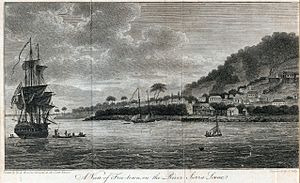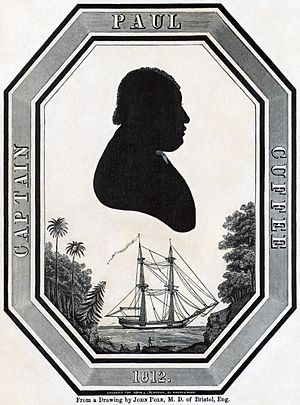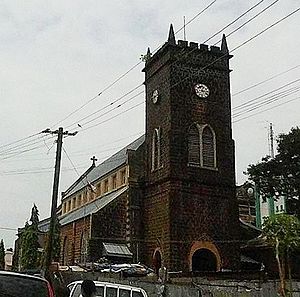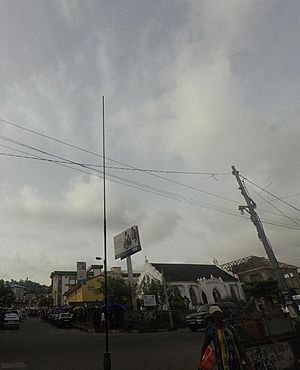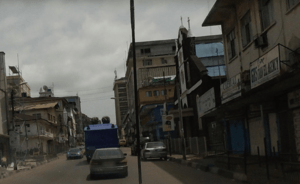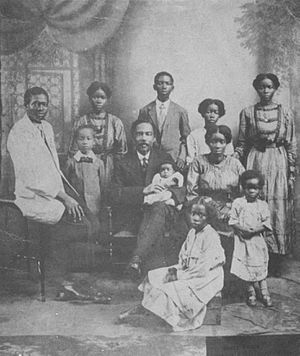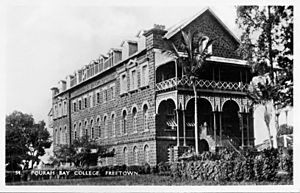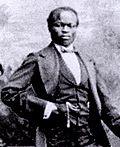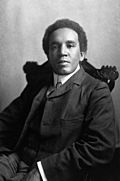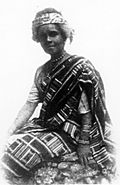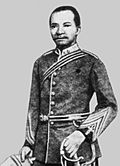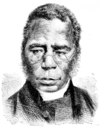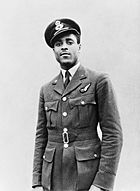Sierra Leone Creole people facts for kids
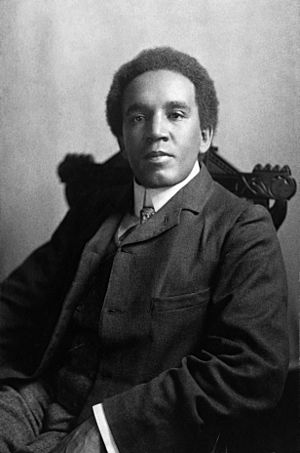
|
|
| Total population | |
|---|---|
| 104,311 (2022) | |
| Regions with significant populations | |
| Sierra Leone, Gambia, United States, United Kingdom | |
| Languages | |
| English • Krio | |
| Religion | |
| Related ethnic groups | |
| African Americans, Afro-Caribbeans, Americo-Liberians, Atlantic Creoles, Black Britons, Black Nova Scotians, Gambian Creoles, Gold Coast Euro-Africans, Jamaican Maroons, Krio Fernandinos, Saro people, Tabom people. |
The Sierra Leone Creole people (Krio: Krio people) are a special group of people in Sierra Leone. They are the descendants of freed slaves from America and the Caribbean. These people, along with freed Africans, settled in Sierra Leone between 1787 and 1885. The British set up this colony with help from people who wanted to end slavery. They created a place for freed people, which they called Freetown. Today, Sierra Leone Creoles make up about 1.2 percent of Sierra Leone's population.
Like their neighbors in Liberia, the Americo-Liberians, Sierra Leone Creoles have some European family history. Some early settlers in Sierra Leone married British colonists and other Europeans. Through the Jamaican Maroons, some Creoles might also have Native American roots. Over many years, freed people from the 'New World' (like Nova Scotians and Jamaican Maroons) mixed with freed Africans (like the Akan, Igbo, and Yoruba). This mixing led to the creation of the Creole ethnic group.
The Americo-Liberians and Sierra Leone Creoles are the only groups in West Africa known to be descendants of African-Americans, freed Africans, and Afro-Caribbeans. The Creoles adopted many Western ways and became close with the British colonial government. They went to British schools and held important leadership roles in colonial Sierra Leone and other British areas in West Africa. Because of this history, many Sierra Leone Creoles have British-sounding first names or last names.
Most Creoles live in Freetown and the nearby Western Area of Sierra Leone. They are also Christians. From their mixed backgrounds, the Creoles developed the Krio language. This language is a mix of English, local West African languages, and other European languages. Krio is now the most spoken language in almost all of Sierra Leone. About 96 percent of the country's population speaks Krio. It helps different ethnic groups communicate, especially when trading. Krio is also the main language for Sierra Leoneans living in other countries.
In the 1800s, Sierra Leone Creoles settled in many parts of West Africa. They formed communities in places like Limbe (Cameroon), Conakry (Guinea), Banjul (Gambia), Lagos, Abeokuta, Calabar, Onisha (Nigeria), Accra, Cape Coast (Ghana), and Fernando Pó (Equatorial Guinea). The Krio language also influenced other local languages, such as Cameroonian Pidgin English and Nigerian Pidgin English. Because of this history, the Gambian Creole people (also called Aku people), the Saro people of Nigeria, and the Krio Fernandinos of Equatorial Guinea are related to the Sierra Leone Creole people.
Contents
Understanding the Creole People
The word "Creole" comes from Portuguese, meaning someone raised in one's house. It has similar words in many languages. In some Spanish-speaking countries, Criollo means something local or typical.
In the Caribbean, "Creole" often refers to all people who are part of the Caribbean culture, no matter their background. For example, in Trinidad, it includes everyone except those of Asian origin.
In Africa, "Creole" describes groups formed during the European colonial period. These groups have a mix of African and non-African cultures. Creole communities are found on most African islands and along the coast where Africans first met Europeans. Five main types of Creoles developed: Portuguese, African American, Dutch, French, and British.
Creole communities have grown in different ways. Their culture, including language and music, is very popular on the islands. In cities founded by Creoles on the African mainland, some non-Creoles have joined Creole societies. This is because Creole society was often seen as having a special status. People who wanted to join a Creole community usually became Christians, as most Creoles are Christian.
A Look at Creole History
In 1787, the British helped 400 freed slaves move to Sierra Leone. These were mainly African Americans freed during the American Revolutionary War, along with Afro-Caribbeans and Africans from London. They settled in a place they called the "Province of Freedom." Many of the first group died from disease and fighting with local people. Only about 64 survived to start a second Granville Town.
In 1792, 1200 Nova Scotian Settlers from Nova Scotia arrived. They were African Americans and their children who had fought for the British in the Revolutionary War. The British had promised freedom to slaves who left rebel masters. After the war, 3,000 African Americans were moved to Nova Scotia. Many found the weather harsh and faced unfair treatment. More than 1,200 chose to move to the new colony of Freetown, which was set up by British people who wanted to end slavery.
In 1800, the British government also sent 550 Jamaican Maroons to Sierra Leone. More African American and Afro-Caribbean immigrants came to Sierra Leone throughout the 1800s and early 1900s.
After Britain and the United States stopped the international slave trade in 1808, their navies patrolled the coast to stop illegal slave ships. The British brought freed Africans from these ships to Freetown. These freed Africans came from many groups, including the Yoruba, Igbo, Efik, and Fante.
Some local Sierra Leoneans were also among the freed Africans brought to Freetown. They joined the Creole culture. Others came to Freetown on their own, seeing opportunities in the Creole society.
Early Settlers: The Black Poor (1787–1789)
The first settlers in Sierra Leone were called the "Black Poor." They were African Americans and Afro-Caribbeans. In May 1787, 411 settlers arrived. Some were Black Loyalists who had fought with the British during the American Revolutionary War, hoping for freedom from slavery.
Many passengers died on the journey. However, enough survived to start a colony. Their settlement was called "Granville Town." The British made a deal for the land with the local Temne chief, King Tom.
More settlers died soon after arriving. After King Tom's death, the next Temne chief attacked Granville Town. The Temne took some Black Poor as slaves. By 1791, only 64 of the original settlers remained. These survivors were called the "Old Settlers."
Nova Scotians and Freetown (1792–1799)
The people in charge of the Sierra Leone colony decided to invite African Americans from Nova Scotia to settle. These were Black Loyalists who had escaped slavery and fought for the British during the American Revolution. The British government had moved over 3,000 freed people to Nova Scotia.
About 1200 of these Black Loyalists sailed to Sierra Leone in 1792. They arrived in Freetown between February and March 1792. On March 11, 1792, they got off their ships and gathered under a large cotton tree. Their preachers held a special service, and the settlement was officially named Freetown. The settlers cleared the land and built a new town where Granville Town used to be.
These "Settlers" had a big impact on Creole culture. Many Western traditions of Creole society came from them. They founded the capital of Sierra Leone in 1792. The descendants of these African Americans were a distinct group until the 1870s, when the Creole identity began to form.
Maroons and Other Immigrants (1800–1819)
The next group to arrive were the Jamaican Maroons. These Maroons came from Cudjoe's Town (Trelawny Town) in Jamaica. They were mostly descendants of skilled Ashanti slaves who had escaped plantations. There were about 551 Maroons, and they helped stop some riots against the British. The Maroons also fought against the Temne during an attack in 1801.
The Temne attacked Freetown in 1801 because they felt they were owed "rent" for the land. The attack failed, and the Temne were forced out of the area.
Smaller groups of immigrants arrived between 1800 and 1819. Afro-Caribbean and freed African soldiers from the West India Regiment settled in Freetown in 1819. Rebels from Barbados who took part in the Bussa Rebellion were also sent to Freetown in 1816.
Thirty-eight African Americans (nine families) moved to Freetown with the help of Paul Cuffe, an African-American ship owner. Americo-Liberian merchants also settled in Freetown in the 1800s and early 1900s.
After the Jamaican Maroons and Barbadian rebels, more Afro-Caribbean immigrants settled in Freetown and nearby areas. They came as missionaries, skilled workers, and colonial officials.
Freed Africans (1807–1830s)
The last major group of immigrants were the "Recaptives" or Liberated Africans. These were people found on slave ships by the Royal Navy after the international slave trade was abolished in 1808.
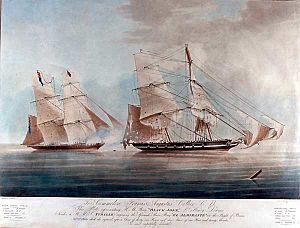
The freed Africans came from many different ethnic groups. They included Akan, Aja, Ewe, Angolan, Wolof, Hausa, Yoruba, Igbo, Bambara, Nupe, and Fulani people. Some Sherbro, Mende, and Temne people who had been enslaved nearby were also among them.
The freed Africans greatly shaped Creole culture. While the Settlers and Maroons brought Christianity and Western influences, the freed Africans kept some of their traditions while also adopting those of the Nova Scotians and Europeans.
The British colonial government helped the Recaptives settle in Freetown. They served in the army and worked as apprentices with Settler and Maroon families. Sometimes, if a child's parents died, a Settler or Maroon family would adopt the child. The groups mixed and became one society.
As the Recaptives became traders and spread Christianity, they started to lead Freetown society. They married Settlers and Maroons, creating a blend of African and Western cultures.
Creole Settlements
The ancestors of the Creoles founded Freetown, Sierra Leone, in 1792. They designed the town like a North American colonial town. The families from Nova Scotia lived in Settler Town.
The Jamaican Maroons arrived in 1800 and settled in Maroon Town. This area was west of Settler Town.
The freed African ancestors, mainly from Yoruba, Akan, and Igbo groups, settled across the Western Area peninsula. By the 1850s, they had established many towns like Aberdeen, Bathurst, Charlotte, and Waterloo.
Between the late 1700s and early 1900s, immigrants from the Bahamas, Barbados, Bermuda, Liberia, and the Gold Coast also settled in Freetown. They eventually became part of the Sierra Leone Creole identity. Today, most Creoles in Sierra Leone still live in Freetown and the surrounding Western Area. Their language and culture have a strong influence, even though they are a smaller part of the population.
In the 1800s, Creole people worked as colonial administrators, traders, and missionaries in other parts of West Africa. Because of this, there are Creole communities in The Gambia, Nigeria, Cameroon, and Equatorial Guinea. Many Sierra Leone Creoles also live abroad in the United States and the United Kingdom. In the United States, Creoles mostly live in Washington DC, Maryland, Virginia, and New York.
Creole Religion
Almost all Creoles (over 98 percent) are Christians. They played a key role in spreading Christianity across Africa. Many of the early settlers from Nova Scotia and the Caribbean were Christians. Many freed Africans also became Christians. From 1840 to 1900, more than half of the black African church leaders in the Anglican Church in West Africa were Creoles. By the 1820s, Sierra Leone had more Christians than all of tropical Africa combined. Places like Fourah Bay College were first set up to train Christian leaders and teachers. These leaders were then sent across West Africa to spread Christianity.
Most Creoles are Protestants. The Anglican and Methodist churches have the most Creole members. Smaller churches like the Baptist church also have Creole members.
Creoles attend traditional 'Creole' churches such as St. George's Cathedral, Freetown, Trinity Church, Freetown, and St John's Maroon Church.
While most Creoles are Protestants, a small number are Catholics. They attend churches like St. Anthony's Church and the Sacred Heart Cathedral, Freetown.
Creole Language
The official language of Sierra Leone is English. However, Sierra Leone Creoles also speak their own special language called Krio. Krio was greatly influenced by British English, Gullah, African American Vernacular English, Jamaican Creole, Akan, Igbo, and Yoruba.
Krio is widely spoken throughout Freetown and nearby towns. So, if someone speaks Krio, it doesn't automatically mean they are from the Creole ethnic group.
Creole people were traders and missionaries in other parts of West Africa in the 1800s. Because Creoles moved around, the Gambian Creole or Aku community in the Gambia speaks a dialect very similar to Krio. Fernando Po Creole English also developed from Sierra Leone Creole migrants. Some freed Africans returned to their homelands, like the Saros of Nigeria. They took their English names and Krio words, like sabi, into Nigerian Pidgin English.
In 1993, there were 473,000 Krio speakers in Sierra Leone. Today, Krio is the most widely spoken language in Sierra Leone, used by 96 percent of the country's population. It helps all the different ethnic groups communicate, especially in trade. Krio is also the main language for Sierra Leoneans living abroad. It has also strongly influenced Sierra Leonean English.
Native Krio speakers of the Creole ethnicity mainly lived in Freetown communities, on the Peninsula, and on the Banana Islands.
Creole Culture
Creole culture is a mix of African, North American, and British cultures. This mix is seen in their Christian beliefs, manners, and values from the Victorian and Edwardian times. Creoles were important in trade and held leading positions in colonial Sierra Leone and other British areas in West Africa. They were influential in many areas like education, technology, business, and public life.
From their earliest days in Sierra Leone, Creoles have contributed a lot to science, literature, art, farming skills, food, clothing styles, music, language, and Christian faith. For example, Nova Scotian Settlers like Thomas Peters were important founding figures of Sierra Leone. In medicine, Davidson Nicol discovered how insulin breaks down in the human body, which was a big step for treating diabetes. John Farrell Easmon named "Blackwater fever" and was the first to link it to malaria. In farming, James Pinson Labulo Davies started cocoa farming in West Africa. William Vivour was the most successful farmer in Africa in the 1800s. Many other notable Creoles were pioneers in various fields.
Marriage and Family Life
Creoles have dating and marriage customs that combine Western and West African traditions. Creole weddings include a special ceremony called gej or put stop. This is like a play where the groom's family formally asks for the bride's hand. Gifts are given, including a calabash, kola nuts, household items, a Bible, a ring, and money.
For weddings, the groom traditionally wears a suit, and the bride wears a white wedding dress. Creoles have church weddings. In the past, relatives would help find suitable partners from good families. Once a partner was chosen, the groom's parents would set a "put stop" day. After this day, the girl was not expected to see other suitors. The night before the wedding, the groom's friends would have a "bachelor's eve" party.
Ashobis (parties) are held on the wedding day or soon after. At these parties, all guests are expected to wear clothes made from the same type of fabric.
Creoles live in nuclear families (father, mother, and children). However, the extended family is also very important. Wealthier family members are expected to help those who are less fortunate, for example, with school fees or job opportunities. In most Creole families, women and older siblings take care of the children, who are expected to help with chores.
Twins in Creole Society
Twins are special to Creoles, who give them unique names. This naming tradition comes from their Yoruba freed African ancestors. The first twin born is usually named Taiyewo or Tayewo, meaning 'the first to taste the world'. This is often shortened to Taiwo. The second twin is named Kehinde, meaning 'the child that came behind gets the rights of the elder'.
Creole Music
Sierra Leonean gumbe music comes from the Jamaican Maroon ancestors of the Creole people. It is mainly vocal and uses drums. This music has been linked to ideas of national pride since colonial times.
The gumbe drum is an important cultural symbol. It is played to create a trance-like state, connecting Creoles with their ancestors. Music is usually made using the gumbe drum, the maracash (a glass bottle and metal object), and a saw.
Today, gumbe music is a key part of Sierra Leone's music scene. It is often mixed with modern music styles to create a unique local sound.
Creole Clothing Styles
Today, Creoles, like other Sierra Leoneans, wear both African and Western-style clothes. Other ethnic groups in Sierra Leone had seen European clothes before the Creoles arrived, due to trade since the 1400s.
However, Western-style dress became popular in Sierra Leone because of the Creoles. In the Victorian and Edwardian eras, Creole men wore a top hat and frock coat. Women wore a petticoat, though some also wore the Jamaican Maroon Kabaslot and Kotoku (a word for money bag).

Creoles still wear fancy clothes for special events like weddings. But they also adopted newer Western styles and African-style dresses in the 1900s.
Today, young Creoles often wear modern teenage fashion like jeans, T-shirts, and sneakers. Older Sierra Leone Creoles still dress formally in Western-style suits and dresses. Some Creole women still wear the Jamaican Maroon Kabaslot, Kotoku, and carpet slippers. They also wear the "print" style, which mixes older African American, Afro-Caribbean, and British dress styles.
Creole Cuisine
For breakfast, some Creoles eat porridge or an English breakfast. This usually includes fried, poached, or scrambled eggs, fried tomatoes or mushrooms, fried bread or toast, and sausages. Lunch often includes Western or Caribbean-style dishes, as well as African food.
Creole meals often follow a weekly schedule. On Saturdays, fufu is often eaten. Fufu is a dough-like paste made from cassava flour. It is served with a type of palaver sauce or plassas (leafy vegetable sauce). This is a spicy dish with spinach greens, tripe, fish, beef, and chicken. It is usually made with palm oil, except for wayt soup (white soup). Other types of Creole plassas eaten with fufu include shakpa, okra, egusi, and krain krain.
Sunday dinner is a West African one-pot meal, like jollof rice or couscous with stew or peanut soup. It often includes plantains and salad. Awujoh meals on Fridays or other special occasions are usually served with sweet potato cooked in palm oil, black-eyed beans, oleleh, agidi, plantain, furrah, and akara with ginger beer. On other days, various local dishes are eaten.
Rites of Passage
Creoles combine British Christian customs with some African rituals for important life events like births and deaths. Creoles have christening and baptism ceremonies. They also have a naming ceremony called pull-na-doh or komojadé on the seventh day after a baby's birth. This celebrates the new baby.
For ceremonies related to death, Creoles have the babichu or barbecue, which comes from the Jamaican Maroons. They also have the awujoh feast, which comes from the Liberated Africans. This feast celebrates the anniversaries of ancestors who have died. Awujoh feasts are held to remember family members, usually on the first anniversary of their death, but also on five, ten, or fifteen-year anniversaries.
In some Creole families, when someone dies, pictures in the house are turned to face the wall, and all mirrors are covered. At the wake before the burial, people clap and sing "shouts" (spiritual songs) loudly. This is to make sure the person is truly gone. The next day, the body is washed, wrapped in burial cloths, and placed on a bed for a final viewing. Then it is put in a coffin and taken to the church for a service, and finally to the cemetery for burial.
The mourning period lasts one year. On the third, seventh, and fortieth day after death, awujoh feasts are held. The feast on the fortieth day marks the spirit's last day on earth. The family and guests eat a big meal. Parts of the meal and kola nuts are placed in a hole for the dead. The mourning period ends after one year (the first anniversary of the death). The mourners wear white, visit the cemetery, and then return home for food and drinks.
Creole Folktales
Creoles have many proverbs and folktales, including Anansi stories. These come from their mixed ancestors, like the Jamaican Maroons and the Akan and Ewe freed Africans. These stories are entertaining and teach Creole values and traditions. Among the most loved are stories about Anansi the spider.
Anansi stories are part of old myths from freed African folklore. They tell about how gods, royalty, humans, animals, plants, and even objects interact.
Creole Culture and Other Sierra Leonean Cultures
Oku People The Oku also came from the freed African community in Sierra Leone. They have historically married some Creole people. However, many experts say the Oku are different from Creoles because of their history and strong Muslim culture.
Unlike the Oku people, Creoles are Christian. They are a mix of different groups, including African Americans, Afro-Caribbeans, and freed Africans of Igbo, Akan, and Yoruba descent. They also have some European family history. Also, unlike the Oku people, Creoles practice monogamy (one spouse).
More recently, some experts consider the Oku to be a sub-group of the Creoles. This is because of their close ties with British colonists and their adoption of Western education and other cultural aspects. Those who see Oku as part of the Creoles note that some Oku adopted English or European last names. They also share cultural practices like egungun, gelede, hunters' masquerade, esusu, awujoh, and komojadé. However, these similarities are often due to shared Yoruba traditions from the Christianized Yoruba freed Africans among the Creoles. The Oku people's main culture, heritage, and identity are Yoruba.
Sherbro People According to anthropologist Anaïs Ménard, the only Sierra Leonean ethnic group whose culture is similar to the Creoles (in terms of adopting Western culture) are Westernized members of the Sherbro people. Many Sherbro people become part of the Creole group because they share the Christian faith and often have similar Western-style last names.
Some Sherbro people interacted with Portuguese and English traders and married them between the 1400s and 1700s. This led to Afro-European families like the Sherbro Tuckers. Because of this, some Sherbro people have a more Westernized culture than other local Sierra Leonean groups.
As Creoles settled in places like Bonthe for trade and missionary work, they married Westernized Sherbros as early as the 1700s.
Creole Architecture
The Creole homeland is a mountainous peninsula on the coast of West Africa. Freetown, the capital, is at its northern tip. The mountains are covered by tropical rainforests with deep valleys and waterfalls. White sand beaches line the Atlantic coast. Sierra Leone covers about 72,500 square kilometers.
Traditional Creole buildings during the colonial period included different styles. These ranged from English-style mansions to smaller stone or brick houses. There were also traditional one or two-story wooden houses built on stone foundations. These houses looked like those found in the Old South of the US, the West Indies, or Louisiana.
The unique style of Creole wooden or "board" houses was brought by the Settlers from Nova Scotia. As early as the 1790s, the Nova Scotians built houses with stone foundations, wooden upper parts, and American-style shingle roofs. Later African-American and Afro-Caribbean settlers also influenced Creole building styles.
Even though some old Creole board houses look worn down, they have a special charm. They feature dormer windows, box windows, shutters, glass panes, and balconies. Wealthy Creoles live in nice neighborhoods like Hill Station, above Freetown. A large dam in the mountains provides this area with water and electricity.
Creole Ancestry
Creole groups were formed during the European colonial era. This happened when many people were moved from their homes and brought into contact with others from different language and cultural backgrounds. They came together in a new colonial land. Often, these settlers were forced to leave their original homes. They had to create new ways of life, languages, and cultures by combining elements from their diverse backgrounds. This process is called creolization.
Like their Americo-Liberian neighbors, the Creoles of Sierra Leone have different levels of European ancestry. This is because some of the settlers were descended from white Americans and other Europeans. For example, Thomas Jefferson's partner, Sally Hemings, was a mixed-race woman whose descendants were among those who moved to Nova Scotia.
After the American Revolutionary War, the Book of Negroes listed about 3000 "black and mixed-race" loyalists who sailed from New York City to Nova Scotia in 1783. Most black families recorded in the US census after the war were found to be descendants of white women (servants or free) and black men (servants, enslaved, or free) in colonial Virginia. Most of those who moved to Nova Scotia were from the Southern United States.
Through the Maroons, some Creoles might also have Native American ancestry. Spanish Jamaica had Spaniards, natives, enslaved Africans, freed black people, mixed-race people, and those born on the island called "creole Africans." Genetic studies on the Jamaican Maroons suggest they have Native American, European, and East Asian ancestors, in addition to African roots.
On the journey from Plymouth, England to Sierra Leone, seventy European girlfriends and wives came with the Black Poor settlers. There was a lot of marriage between the Europeans who settled in Sierra Leone and the different groups that formed the Creole identity. Settlers generally married within their own group. However, mixed-race and European individuals married outside their groups more often. Mixed-race people married Europeans and black colonial residents at the same rate as they married people of their own background.
Along with the Americo-Liberians, the Creoles of Sierra Leone are the only recognized ethnic group in West Africa with African-American, freed African, and Afro-Caribbean roots.
Sierra Leone Creole People Around the World
Historical Communities
Historically, Creoles spread Christianity and their main language (Krio) throughout West Africa. Because of this, Sierra Leone Creole communities existed in Nigeria, Ghana, Cameroon, Senegal, Equatorial Guinea, and Liberia. Many Creoles traded across West Africa, and some settled in new countries.
Freed Africans and their children born in the colony in the early to mid-1800s, and later Creoles in the late 1800s and early 1900s, who settled in Nigeria, were known as Saros. There is still a thriving community there. Sierra Leone Creoles who settled in the Gambia became part of the Aku or Gambian Creole people. They form an important community in Gambia. Many freed Africans returned to their original homes after being freed in Freetown. Most kept their English names, taking on new identities in their homelands.
Present-Day Communities
Due to normal migration, the Sierra Leone Civil War, and some unfair treatment at home, many Sierra Leone Creoles now live abroad in the United States and the United Kingdom. This movement of Sierra Leone Creoles abroad is called the "Creole Diaspora." Many Creoles attend formal and informal gatherings. A Creole or Krio Heritage Society is based in New York City, with branches in places like Texas.
Related Communities
- Black Nova Scotians – ancestors of the Sierra Leone Creoles who fought for their freedom with the British during the American Revolutionary War. They first settled in Nova Scotia and then founded Freetown, Sierra Leone in 1792.
- Jamaican Maroons – ancestors of the Sierra Leone Creoles who freed themselves from slavery in Colony of Jamaica. After the Second Maroon War, they first settled in Nova Scotia and then arrived in Freetown in 1800.
- Americo-Liberians – a sister ethnic group to the Creoles of Sierra Leone. They are made up of African Americans, Afro-Caribbeans, and freed Africans who founded Liberia in 1822.
- Gambian Creoles – descendants of the Sierra Leone Creoles who moved to The Gambia in the late 1800s and early 1900s.
- Saro people (Nigerian Creoles) – a sub-group of the Sierra Leone Creoles who settled in several Nigerian cities in the late 1800s and early 1900s.
- Krio Fernandinos – descendants of the Sierra Leone Creoles who moved to Bioko island, Equatorial Guinea in the late 1800s.
- Gold Coast Euro-Africans – often married Sierra Leone Creole migrants in colonial Ghana.
Notable People of Sierra Leone Creole Descent
| Name | Born | Died | What they are known for | Ref. | Image |
|---|---|---|---|---|---|
| William Vivour | 1830 | 1890 | The most successful farmer in Africa in the 1800s | ||
| Davidson Nicol | 1925 | 1994 | Discovered how insulin breaks down in the human body, helping treat diabetes | ||
| James Pinson Davies | 1828 | 1906 | Pioneer of cocoa farming in West Africa | ||
| John Farrell Easmon (seated, with brother Albert) | 1856 | 1900 | Named "Blackwater fever" and was the first to link it directly to malaria | ||
| Christian Frederick Cole | 1852 | 1885 | First black graduate of Oxford and first African barrister to practice in English courts | ||
| Sir Samuel Lewis | 1843 | 1903 | First mayor of Freetown and first West African to receive a knighthood | ||
| Stella Jane Thomas | 1906 | 1974 | First black African woman to become a lawyer in Great Britain and West Africa | ||
| Samuel Coleridge-Taylor | 1875 | 1912 | Composer and conductor known for his three cantatas based on the poem The Song of Hiawatha | ||
| Idris Elba | 1972 | — | Actor and winner of BET and Golden Globe Awards | ||
| Frances Claudia Wright | 1919 | 2010 | First Sierra Leonean woman to become a lawyer in Great Britain and practice law in Sierra Leone | ||
| Dame Linda Dobbs | 1951 | — | First non-white High Court judge in Great Britain | ||
| Constance Cummings-John | 1918 | 2000 | Educator, politician, and first mayoress of Freetown | ||
| Emanuel Adeniyi Thomas | 1914 | 1945 | First black African to become a pilot and first Royal Air Force officer of West African origin | ||
| Sir Kitoye Ajasa (born: Edmund Macauley) | 1866 | 1937 | Legislator during colonial times and first Nigerian to receive a knighthood | ||
| Sir Ernest Beoku-Betts | 1895 | 1957 | Jurist and former mayor of Freetown | ||
| Charles Odamtten Easmon | 1913 | 1994 | Performed the first successful open-heart surgery in West Africa | ||
| Sir Henry Lightfoot Boston | 1898 | 1969 | First African Governor-General of Sierra Leone | ||
| Christopher Okoro Cole | 1921 | 1990 | Chief Justice, later interim Governor-General and President of Sierra Leone | ||
| Adelaide Casely-Hayford | 1868 | 1960 | Activist and pioneer of women's education in Sierra Leone | ||
| Gladys Casely-Hayford | 1904 | 1950 | Playwright and first author to write in the Krio language | ||
| Clifford Nelson Fyle | 1933 | 2006 | Author of the Krio-English Dictionary and the Sierra Leone National Anthem | ||
| William Broughton Davies | 1831 | 1906 | First West African to become a medical doctor | ||
| Ulric Emmanuel Jones | 1940 | 2020 | First Sierra Leonean neurosurgeon | ||
| Andrew Juxon-Smith | 1931 | 1996 | Commander of the armed forces and Head of State of Sierra Leone | ||
| James Africanus Horton | 1835 | 1883 | Surgeon, scientist, and political thinker who worked for African independence a century before it happened | ||
| Agnes Yewande Savage | 1906 | 1964 | First West African woman to become a medical doctor | ||
| Murietta Olu-Williams | 1923 | — | First woman in Africa to reach the rank of Permanent Secretary in the Civil Service | ||
| Charles Burgess King | 1875 | 1961 | Former President of Liberia | ||
| Samuel Ajayi Crowther | 1809 | 1891 | Clergyman and first Anglican Bishop of West Africa | ||
| Adesanya Kwamina Hyde | 1915 | 1993 | Royal Air Force aviator awarded the Distinguished Flying Cross for bravery | ||
| Valentine Strasser | 1967 | — | Army officer and Head of State of Sierra Leone | ||
| John Clavell Smythe | 1915 | 1996 | Royal Air Force aviation officer shot down over Nazi Germany, later attorney-general of Sierra Leone | ||
| George Gurney Nicol | 1856 | 1888 | Clergyman and first African graduate of Cambridge University | ||
| Napheesa Collier | 1996 | — | Professional basketball player and gold medalist at the 2020 Summer Olympic Games | ||
| Leonard Benker Johnson | 1902 | 1974 | British Empire Boxing champion, considered one of the best middleweights of his time. |
See Also
- African-American diaspora
- African Americans in Africa
- African Americans in the Revolutionary War
- Atlantic Creole
- Atlantic World
- Back-to-Africa movement
- Birchtown, Nova Scotia
- Book of Negroes
- Creolization
- Church Missionary Society
- The Cotton Tree
- Door of Return
- Dunmore's Proclamation
- Gullah
- Gumbe
- Jamaican Maroon Creole
- History of Sierra Leone
- Outline of Sierra Leone
- Philipsburg Proclamation
- Rough Crossings
- Sierra Leonean nationality law
- Timeline of Freetown


